How Oxfam used new power in the 1960s to help a group of teenagers raise £5 million.
A short while ago I met up with Giles Pegram to record his reflections and thoughts about why people give? (which you can hear here). As part of this discussion, Giles told me how he got into fundraising.
His story repeatedly brought to mind the concept of New Power which seems to be attracting growing interest in the fundraising sector.
For those who haven't heard the term, New Power differs to old power. Old power is held by a few. It is closed, inaccessible, controlling and leader-driven. New power is open, participatory, and peer-driven. It is compared to a current in that it distributes power and is most forceful when it surges. The goal with new power is not to try to control it but to channel it. It grows stronger when people work together.
Giles' story shows that New Power has been part and parcel of successful fundraising for many years. Along with a group of teenage friends, he set up a fundraising event from scratch that raised in excess of £5 million in today's money.
As you read it, you'll see how Oxfam recognised the power within a group of determined teenagers and gave them the support they needed to create a remarkable fundraising success. Giles and his friends didn't play by the rules (which they probably didn't understand). And that was probably the reason why they did so well. They used social networks, identified influencers, understood supporter needs and had great, instinctive, management skills.
Oxfam engaged, involved and encouraged the young team, The charity didn't try to take control.
There are some terrific lessons for us in 2020 - particularly for those who are trying to create today's social movements, successfully introduce new ideas or improve the supporter experience.
Perhaps the most important take away is that success is dependent on getting the basics right. What might happen if you change your standard thank you to something that shows the donor they are really valued? This is particularly important if you know a group of people have got together to raise money for your charity. Giles has more to say about that later. The rest follows in his own words.
-----------------------------------------------------------------
This is a story about a thank-you letter. The first thank-you after a first gift. Other parts of what follows may be interesting and even amusing, but they are all part of the story about that one thank-you letter. And there’s a moral at the end.
When I was ten years’ old a nice lady from the Oxford Committee for Famine Relief (since renamed OXFAM) talked in assembly about the need in what was then called the Third World, and what OXFAM was doing to help meet that need.
I was impressed. I appointed two friends as sub-editors, and started to produce a monthly ‘School News’ which we sold in the playground for 1 penny a copy.
The group grew and we organised a jumble sale at St Barnabas Church Hall, in Temple Fortune. We raised £80 which I proudly sent to OXFAM. When I received a letter just two days’ later I was surprised. As a twelve-year-old I never received letters, except on my birthday. When I opened it I experienced feelings I’d never felt before (and am not sure I’ve felt since). A letter hand-signed by the Director of OXFAM, no less, and completely personal to me. Please read it carefully. Maybe I’m biased but I don’t think I’ve ever seen a better thank-you letter, 57 years on.
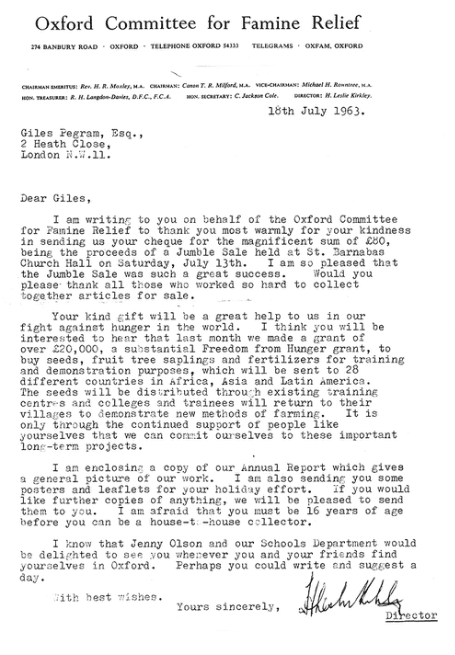
It was addressed to me, was personal, and, by talking about OXFAM’s work during the previous month, made me feel that I, me, had directly contributed to that work. My group of friends were equally thrilled and delighted. It had been a team effort. For the next week I carried it around and showed it to whomever was interested, and many who probably weren’t. It’s amazing it has survived to this day.
From that moment on, every hour of every day, after school, was devoted to organising my friends to help raise money for OXFAM.
When we were 16 we took on our first sponsored walk. It was only within our school, UCS, but almost every-one in the school took part. 500 walkers raised £2,500. (£45,000 in today’s money.)
The following year we broadened our horizons, involved all the local secondary schools, and even went further afield. We took over a little-used room in the School – the Science Masters’ Common Room. We were allowed to bring in a paid secretary to work from the room. I wanted a telephone. I went to see the Headmaster. C. D. Black-Hawkins was a prime example of nominative determinism. He was austere: deliberately distant. I humbly asked him about the phone. Unfortunately (for him) he took the wrong tack. Instead of just saying ‘No’, and sending me packing, he said that we could never possibly get a phone installed in the couple of days required.
“Yes, Headmaster, but just suppose we could?” Check mate. A telephone was in the office two days later.
My mother worked at the BBC, so I knew the layout of Broadcasting House quite well. One evening, having stood outside and assuaged our nerves, four of us walked through the front door with an air of unassailable confidence. We simply walked past Reception into the main building. Then collapsed in a heap. We’d done it. We were in. We then navigated the labyrinthine, empty, corridors until we found the studio from which Radio 2 was broadcasting. We knocked on the door. Stephen Rayment, a few months older than the rest of us, did a stonking interview. (I understand that the following day, at Broadcasting House, questions were asked, heads rolled, and security was tightened. Frankly, not our problem.)
In 1968 there were 2,000 walkers raising £10,000 (that's the equivalent of £170,000 today.)
What next?
Given the growth from 1967 to 1968, why not aim for 50,000 walkers and £250,000? (£5 million today.) Why not? Not as an end in itself, but because we had been brilliantly stewarded by OXFAM, been round their Head Office, met people who had talked about their work, and felt genuinely thanked, appreciated and inspired to want to do more. We wanted to raise as much money as we possibly could, so as to make as much change as we possibly could.
Pure altruism? Not at all. We loved it. And we were making a difference to the world. At 18 that was powerful stuff. Much better than playing cricket.
We had done university entrance exams in November. We were due to start university in the autumn. So we had time. Previous walks had been in July and we were creatures of habit. So, July it was. Sunday July 13th 1969. Just over 50 years ago.
OXFAM backed us. They found us a condemned shop in Archway to turn into an office with donated furniture from Barclays Bank. I nabbed a bank manager’s desk and a swivel chair. I could learn to live like that. This was a bit different from school. Nine of us started, working full time – and the rest.
We had decided to have twelve 30-mile routes from all around London, ending in a central venue. But where? We thought of Hampstead Heath. Then one of our group, Roger Crombie, typed this memo to David Albury, my deputy, and me.
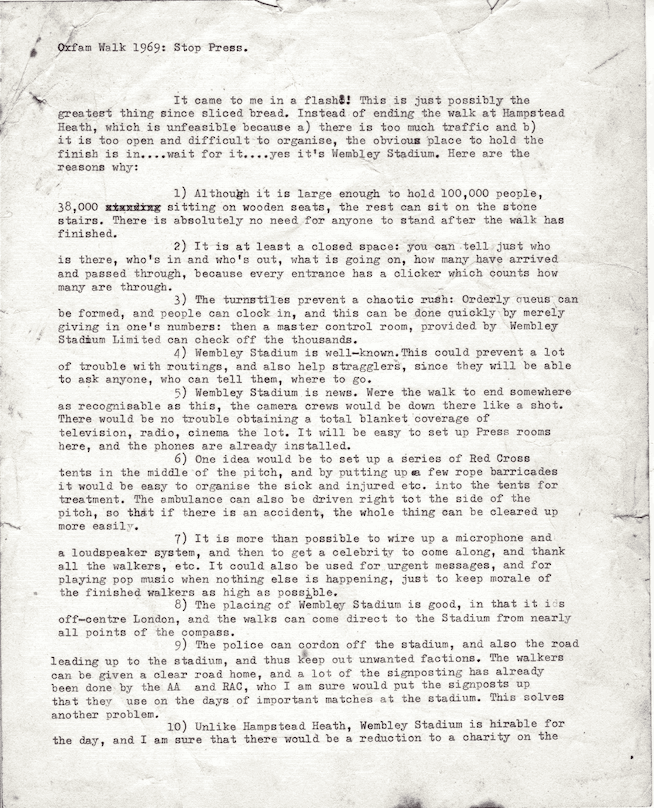
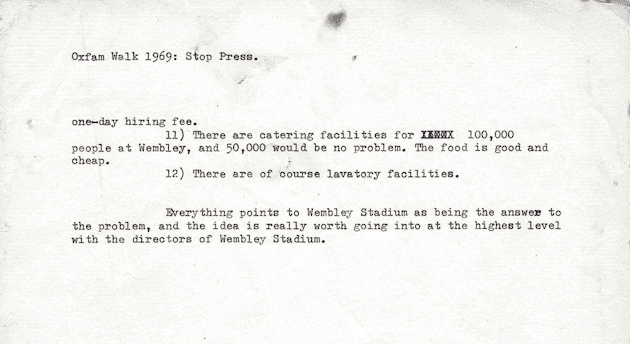
Wembley Stadium!
For most 18-year olds this would be silly talk. Because we believed in what OXFAM was doing, ‘silly’ was absolutely the right thing to be. People were starving. We weren’t. So we gave ourselves permission to think silly things, and then make them happen. David and I booked an appointment with the Managing Director of Wembley Stadium, at which we booked the Stadium and soon after signed the contract.
We wanted to write to all 5,000 head teachers in the South East.
Who should sign it?
After some discussion we identified that, in 1969, Rab Butler was the single person who would have most credibility with head teachers. He was known as "the creator of the modern educational system”. So where was he now? He was Master of Trinity College Cambridge.
I wrote my first ever piece of direct mail. (I thought it was quite good. It sounded like him even though I’d only ever seen his photo.) David and Peter Holland drove to Trinity College and knocked on the Master’s door. He answered the door, listened with interest, and signed the letter without changing a word.
I also did the creative. His own notepaper, where we found the right, slightly beige, thick stock, and had the letter printed with an embossed red address, typewritten black text, and a blue signature, printed with slow drying ink, so that the signature would smudge if rubbed with a damp thumb.
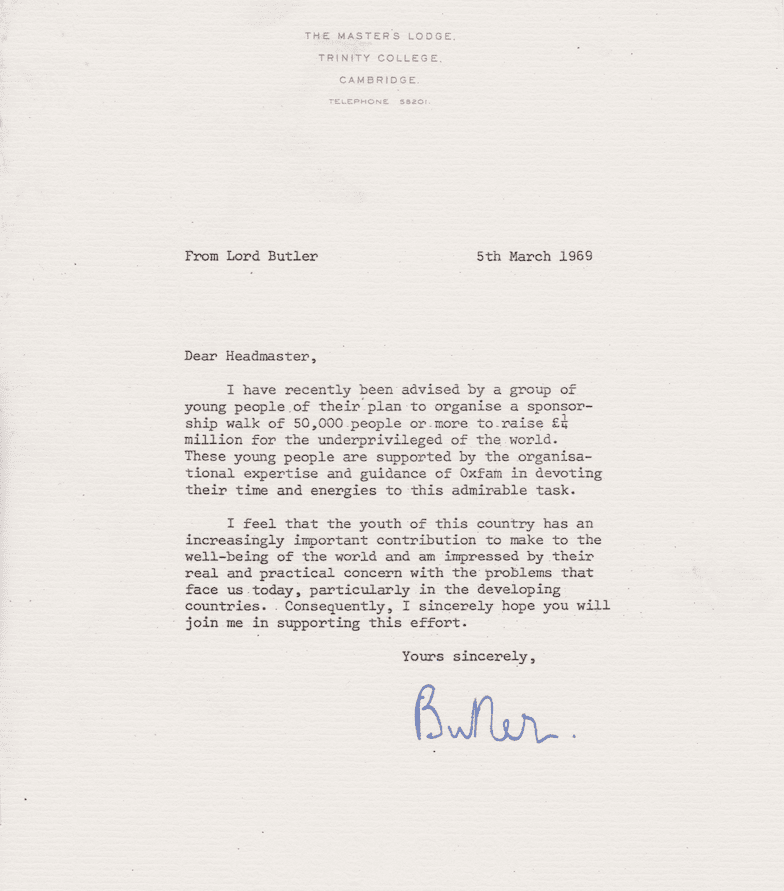
Once ready to post, we took the 5,000 envelopes, in the back of a car, up to Trinity College, and persuaded the porters to let us post them from the College, so that each letter would arrive with a ‘Trinity College’ postmark on the outer envelope.
Compromise? Be realistic? No.
There was no ‘agency’ involved. No ‘creatives’, no ‘account managers’, no ’meetings’. It wasn’t costed and there was no way of measuring response. We just followed our instincts to produce the very best possible letter because we believed it was right.
This is one example, not unique. Lord Hunt, conqueror of Everest, wrote to all Youth Clubs. Vic Feather, General Secretary of the TUC, wrote to all trade unions. Martin, our press person, hawked our press release round every national newspaper, one by one. And much, much more. Our actions were limited only by our imaginations.
OXFAM got their advertising agency, AB&A, involved. David and I met with them frequently. The notes of our meetings were written up in a ‘Contact Report’, a copy of which was sent to their top man, a certain Harold Sumption. I think I met him once but that may be wish fulfilment.
They had a great, and young, PR man, John Bailey, who became very involved in our work. He asked to see all the letters from outside the internal walk correspondence and pored over them. He came across one: a letter from a vicar complaining that we were organising Walk 69 on a Sunday. That was it. Together he and David drafted a press release, arguing that 50,000 teenagers raising £5,000,000, for OXFAM’s beneficiaries, and, in so doing, becoming aware of the plight of much of the Third World, was a Good Thing. They attached the letter from the vicar. The media loved it. (In retrospect, I do believe we should have at least told the vicar.)
Meanwhile, David and I would drive to Oxford every fortnight to meet the key OXFAM people, both to keep them up-to-date, and to ask them for any further help or advice we might want . They gave us support, encouragement and motivation.
Our final silly idea was to organise a pop concert at Wembley Stadium, to entertain the walkers when they finished their 30 miles. We twisted the arms of many of the biggest names of 1969. You will know of Status Quo, Yes, Love Affair and Alan Price. And there were many others.
After ‘A levels’ at UCS, sixth formers were given permission to come to the office to help out. It was a hive of activity. There was heaps to do.
We always knew that the day itself would be an extraordinary feat of organisation. I’ve mentioned Stephen Rayment. Because he was a few months’ older than the rest of us, he was put in charge of the day itself right at the beginning. (Stephen had those few months’ extra maturity to cope with such a huge task.)
There were 30 starting points to be organised. Then 360 miles of routes to be looked after. Safety was paramount. We had liaised with the Metropolitan Police, St John Ambulance and with caterers to provide refreshments on the route. (It was extraordinarily hot. St John Ambulance described it as their biggest ever London operation.) Teenagers organised the check-in process, the checkpoints on the route and all that happened at Wembley Stadium.
But we were not foolish enough to think that we could safely organise 50,000 walkers along 360 miles of London roads. We recognised our limitations. Stephen recruited mature, sensible, adults as Chief Marshals and Marshals. Teachers from UCS. Parents. People who would take the huge responsibility for the walkers whilst on the Walk. We had organised materials. Large ‘Caution. Walkers’ signs to be attached to lampposts, direction arrows, and trailers that could be attached to cars to act as tail-end Charlies, taking down the signposts and clearing up the debris. There was no shortage of able volunteers. Once Stephen was sure that each Chief Marshal knew what he/she had taken on, and had the resources from us to help them deliver, we stood back.
A short video describing the events of the day still survives. Just listen to the commentator. It’s of another era.
Then there was Wembley Stadium itself. 50,000 walkers descending from all over. The logistics just of that. At the same time organising the concert. And looking after the VIPs and celebrities. Reading telegrams of support on the Tannoy system.
And then, after the concert, the logistics of getting people to the right coaches to get them back home.
Of course, it was organised chaos. But it was organised. Stephen had done a huge amount of preparation and anticipation.
On the Monday after the walk there was phenomenal coverage in the national and local press. The Sun gave it five pages. It was the first (and only) time my name was on the front page of the Times.
A week or two later, the then Deputy Director of OXFAM, Nick Stacey, and our key contact, Phillip Jackson, took us all for dinner in a private room at Hungarian Restaurant the Gay Hussar, and made us all feel very special and very proud. Once again, extraordinary stewardship.
After Walk 69, I took a degree in Logic and was then head-hunted by Help the Aged to organise replicas of Walk 69 around the country. And, now, in 2020, I’m still totally committed to fundraising.
And all because of that one thank-you letter 57 years ago. When I left NSPCC, I was given a scrapbook. The finance and planning team calculated that, in today’s money, I had been responsible for the raising of £2.5 billion, in today’s money, for the NSPCC, alone.
Was there something unique about OXFAM that prompted all of this? I’ve thought carefully, and the answer is ‘no’. It could just as easily have been NSPCC, CRUK or Save the Children.
There were just two things that drove us to OXFAM. That thank you letter, and the subsequent stewardship.
The absolute commitment to OXFAM and its work were a consequence of those two factors and the way they drew us in. At the beginning, it was the stewardship not the cause. The cause came later.
I recently worked with one of my clients on a mystery shopping exercise by sending a donation to 20 charities, large and small. What was the most common response? A brilliant, carefully crafted letter of appreciation engaging the donor with the work they were making possible?
No.
A request for another donation, perhaps?
No. A book of raffle tickets.
I was astonished. And sad. And angry. And I still am.
The moral of this story? Look very carefully at the first communication you send to a first-time donor, and how long it takes you to send it. It should be the most carefully crafted communication in your armoury. It could lead to extraordinary things.
Do you even know what yours looks like?
Giles Pegram CBE. Organiser OXFAM Walk 69.
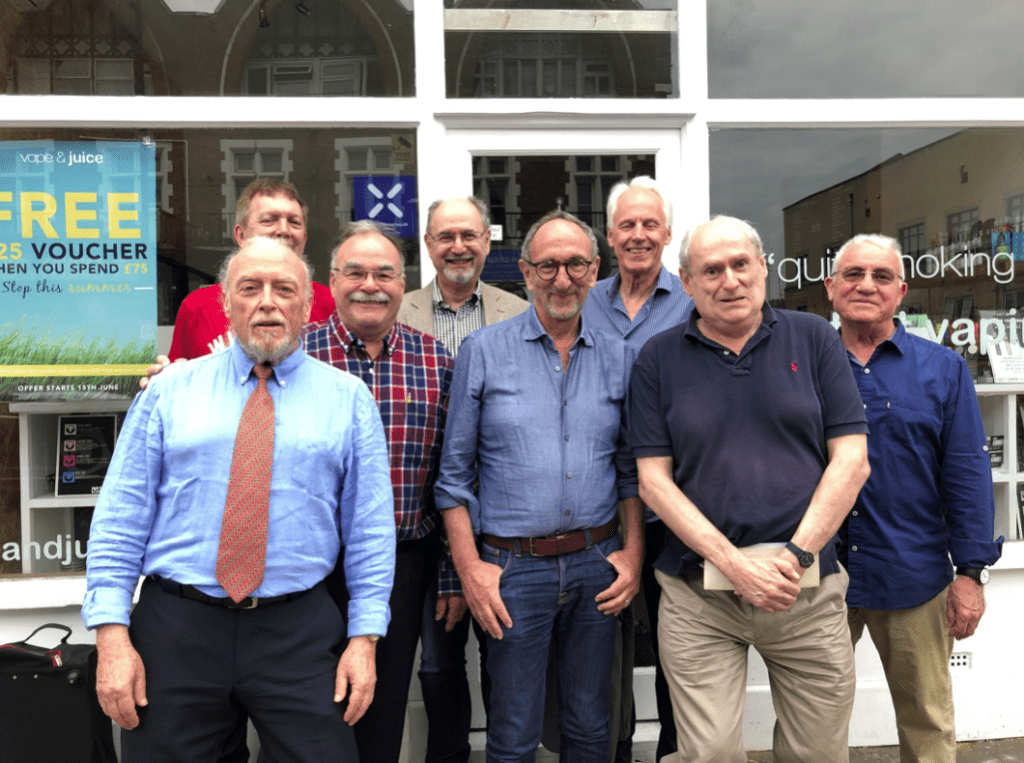
The full organising team included: Roger Crombie, Martin Amor, John Cattanach, Peter Holland, David Albury, Stephen Rayment, Giles Pegram, Nick Goodyer
Tags In
The Essentials

Crack the Code to Regular Giving: Insights, Strategies, and a Special Giveaway!

‘Tis Halloween. Keep to the light and beware the Four Fundraisers of the Apocalypse!

Why do people give? The Donor Participation Project with Louis Diez.

A guide to fundraising on the back of a postcard

What does the latest research tell us about the state of fundraising?






